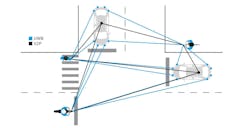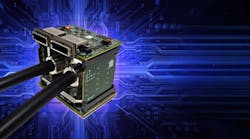Revolutionizing Vehicle Safety: The Role of UWB in Modern Automobiles
What you’ll learn:
- The transformative role of UWB technology in the automotive industry.
- How it enhances applications like vehicle occupancy detection, keyless entry systems, and road safety.
- The integration of UWB into automobiles.
In the ever-evolving landscape of automotive technology, ultra-wideband (UWB) stands out as a beacon of innovation, particularly in the domain of vehicle occupancy detection. This cutting-edge technology, known for its low-power wireless capabilities, is now paving the way for advanced safety measures and convenience in vehicles.
Technology continually enhances our daily lives, but for it to be truly effective, it must be straightforward, secure, reliable, and trustworthy. Radio-frequency (RF) technologies like Wi-Fi and Bluetooth have significantly improved connectivity in our homes and businesses. However, UWB emerges as a secure, reliable, and trustworthy RF technology with a unique capability to enhance our lives.
While UWB's applications are vast, this article will focus on its critical role in lifesaving vehicle applications, offering a glimpse into the future of safer and more interconnected driving.
UWB: A Multifaceted Technology in Automotive Innovation
The automotive industry is rapidly integrating new technologies to improve safety, security, and the overall consumer experience. Addressing traffic safety, technology has evolved from standalone vehicle systems, like radar and cameras, to connected-vehicle technologies requiring standardization across manufacturers.
This shift toward vehicle-to-everything (V2X) communications opens the door for UWB technology, combining precise positioning, secure identification, and ultra-low latency to enhance advanced driver-assistance systems (ADAS), and connected and autonomous vehicles (CAVs).
One of the critical applications of UWB in automobiles is its ability to detect occupancy, especially in situations that could lead to life-threatening scenarios, such as a child being left unattended in a hot car (Fig. 1). UWB leverages the unique property of channel impulse response (CIR) to distinguish whether a seat is occupied.
That’s achieved by transmitting UWB pulses within the vehicle, where the signals reflect off surfaces until they reach a receiver. The key lies in the strategic placement of transmitters and receivers to ensure the signals traverse passenger seating areas. When a seat is occupied, the CIR signature changes, enabling the system to detect the presence of a person. This application not only enhances safety, but also introduces a new level of interaction between the vehicle and its environment.
Beyond Occupancy Detection
Beyond occupancy detection, UWB’s utility extends to several other automotive applications, including keyless entry systems known as Digital Key. This implementation showcases UWB's versatility in improving vehicle security, convenience, and situational awareness.
Digital Key, developed by the Car Connectivity Consortium (CCC), uses UWB for a secure, hands-free way to unlock and lock your car as you approach or leave, without taking your mobile device or smartphone out of your pocket. The Digital Key application, which combines UWB with Bluetooth Low Energy (BLE), exemplifies how vehicles can securely authenticate and communicate with a driver's smartphone or smartwatch (Fig. 2).
In this system, a UWB-enabled smartphone or key fob transmits signals received by multiple vehicle-mounted UWB anchors, which reply in sequence. In turn, the vehicle can calculate the precise distance to the smartphone or user.
This Digital Key process is safeguarded by a security feature that uses a scrambled timestamp sequence (STS) protected by the Advanced Encryption Standard (AES) protocol. The process is protected by a complex algorithm that refreshes the STS code after every transmission. This ensures that only authorized devices can communicate.
Furthermore, alongside UWB, BLE is utilized for initial high-level communication to exchange Digital Key IDs and verify user identity, further enhancing security and preventing unauthorized access. The innovative Digital Key vehicle entry and exit procedure offers a seamless and secure user experience (Fig. 3).
In high-speed situations with multiple vehicles, it's crucial that CAVs work flawlessly. One example is platooning, where vehicles move closely together to save fuel by reducing air resistance (Fig. 4). This method can make trucking safer and more efficient, lowering fuel expenses and emissions, easing traffic, speeding up deliveries, and even extending the distance electric vehicles can travel on a single charge.
Moreover, UWB's application in short-range radar systems illustrates its potential in collision-avoidance technologies. By analyzing the time of arrival of reflected signals, UWB can accurately determine the distance to nearby objects, enabling vehicles to alert drivers of potential hazards.
Improving Safety for Pedestrians and Cyclists
UWB technology can also significantly improve safety for pedestrians and cyclists by working together with vehicle-to-pedestrian (V2P) communication (Fig. 5). Just like vehicle-to-vehicle (V2V) communication, UWB helps the navigation system to identify if a vulnerable road user (VRU), such as when someone with a smartphone or any UWB-enabled device is nearby. It then measures the distance to the VRU accurately and checks if there's a risk of collision.
For example, at a three-way stop or any intersection, vehicles equipped with UWB sensors can detect the exact location of VRUs, helping to prevent accidents and keep the roads safer for everyone.
As we look to the future, the potential applications of UWB in the automotive sector are vast and varied. From facilitating electric-vehicle charging alignment to enabling secure payments in parking garages and improving road safety for pedestrians, UWB technology holds the promise of transforming our driving experiences.
The integration of UWB into automobiles isn’t just about enhancing vehicle functionality; it's about creating a safer, more convenient, and interconnected driving environment. With industry predictions suggesting that half of all new vehicles will incorporate UWB technology in the near future, the stage is set for a significant leap forward in automotive safety and innovation.
Looking Forward
UWB technology represents a critical step forward in the automotive industry. It offers enhanced safety and security, and opens the door to a plethora of innovative applications that promise to revolutionize the way we interact with our vehicles. As this technology continues to evolve, it will undoubtedly play a pivotal role in shaping the future of automotive design and functionality, making driving a safer, more efficient, and more enjoyable experience for all.







